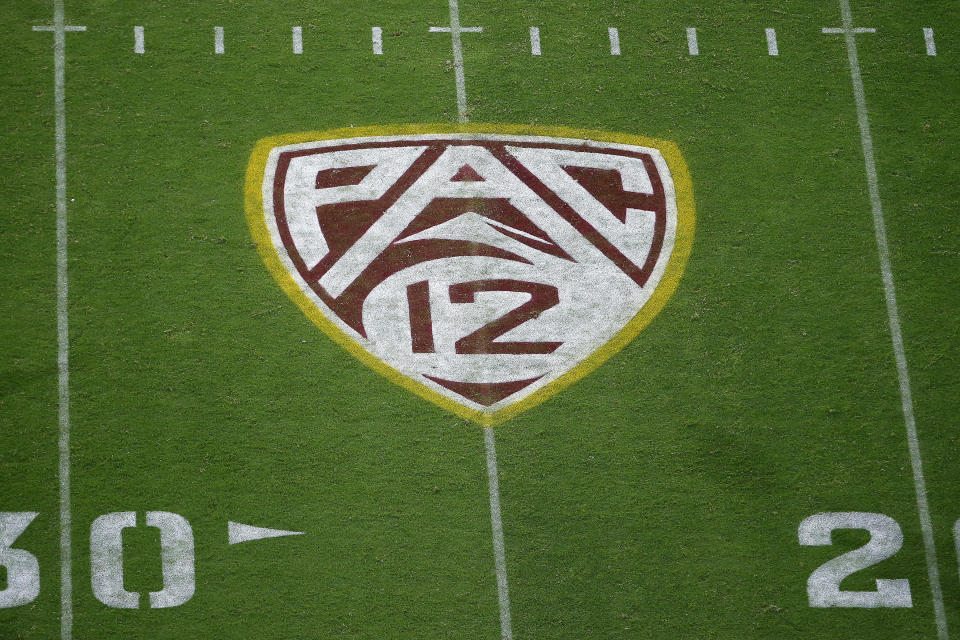Report: Pac-12 finalizing plans for 10-game football schedule starting Sept. 19
The Pac-12 is finalizing plans for a 10-game, conference-only football schedule that would begin the weekend of Sept. 19, according to the San Jose Mercury News.
Two weeks ago, the Pac-12 joined the Big Ten in announcing it would play only conference games in 2020. Now, the conference is putting together the final touches on a plan to begin the season on Sept. 19, which would have been Week 3 under normal circumstances. But the coronavirus pandemic has caused the conferences to get creative, and the Pac-12 is looking to play out its 10-game schedule over a 14-week span with maximum flexibility.
The final version of the plan is expected to be released publicly next week. Here’s what it could look like, per the Mercury News:
10-game regular season, beginning Sept. 19: five division games, five crossover games.
Schedule could drop down to nine games if Pac-12 presidents “prefer a more conservative approach.”
At least two bye weeks built into the schedule to create flexibility to move games around if necessary.
Teams begin preseason camp in mid-August, pending approval from local health officials.
Pac-12 title game at Allegiant Stadium in Las Vegas could be played Dec. 4, Dec. 11-12, or Dec. 18-19.
The plan is being assembled by a group of athletic directors, coaches and directors of football operations in consultation with the Pac-12’s coronavirus advisory committee. It includes a caveat which, of course, could potentially derail things in a big way:
“They are assuming some success in the next month or two [against the virus],” one source said.
When the Pac-12 announced its decision to move forward with a conference-only schedule for all sports, not just football, commissioner Larry Scott pointed to safety and flexibility as the keys to fitting a season in during such uncertain times.
“The health and safety of our student-athletes and all those connected to Pac-12 sports continues to be our No. 1 priority,” Scott said. “Our decisions have and will be guided by science and data, and based upon the trends and indicators over the past days, it has become clear that we need to provide ourselves with maximum flexibility to schedule, and to delay any movement to the next phase of return-to-play activities.”

What about the other conferences?
Though they are competing for the same prize, these conferences operate independently and have to act in their own best interests in an unprecedented situation like this. With this apparent scheduling model in the works, the Pac-12 is doing just that. The Big Ten, which was the first conference to decide to play a league-only schedule, is also in the process of assembling a conference-only schedule.
Even though members of a conference like the Big Ten are scattered across multiple states, they will all be following the same steps and taking the same safety precautions when it comes to the coronavirus.
Big Ten commissioner Kevin Warren told Yahoo Sports’ Pete Thamel earlier this month that a conference-only scheduling approach gives the conference the ability “to be nimble and agile in an uncertain time.”
“It all ties back to the health and safety of our student-athletes. It’s easy for us to manage operations, the schedule and logistics when we’re focused on the Big Ten conference,” Warren told Yahoo Sports.
Meanwhile, the three other power conferences — the ACC, Big 12 and SEC — are reportedly working together on a so-called “plus-one” scheduling model. For an example, the conferences would play a full league schedule, plus at least one non-conference game — presumably with a regional opponent.
CBS reported Wednesday that the “plus-one” model could help preserve some of college football’s annual rivalry games:
The "plus one" structure would preserve traditional SEC-ACC rivalry games this season in a limited schedule — Florida-Florida State, Georgia-Georgia Tech, South Carolina-Clemson, Kentucky-Louisville — that would otherwise be lost in a conference-only format.
Many challenges still ahead
Earlier this week, Yahoo Sports’ Pete Thamel reported that the NCAA’s recommendations for coronavirus contact tracing are a major obstacle in attempting to play a college football season.
While college contact tracing rules are determined by individual schools with guidance from state and local government, the NCAA recommended 14 days of quarantine for anyone with a high risk of exposure to COVID-19. (This includes members of opposing teams following a game.) That has led to hundreds of players around the country, who’ve had no symptoms, being isolated for two weeks out of caution.
Football, obviously, is a contact sport. Should a player test positive after participating in a practice or game, he would have come into contact with many others.
There is also the campus environment that college athletes will be living in. Athletes will presumably be interacting with regular students, making them susceptible to contracting the virus.
So while the news that trickled out from the Pac-12 on Thursday should bring some sense of optimism about the prospects of a college football season, know that it will still be an extremely difficult undertaking.
More from Yahoo Sports:

 Yahoo Lifestyle
Yahoo Lifestyle 
